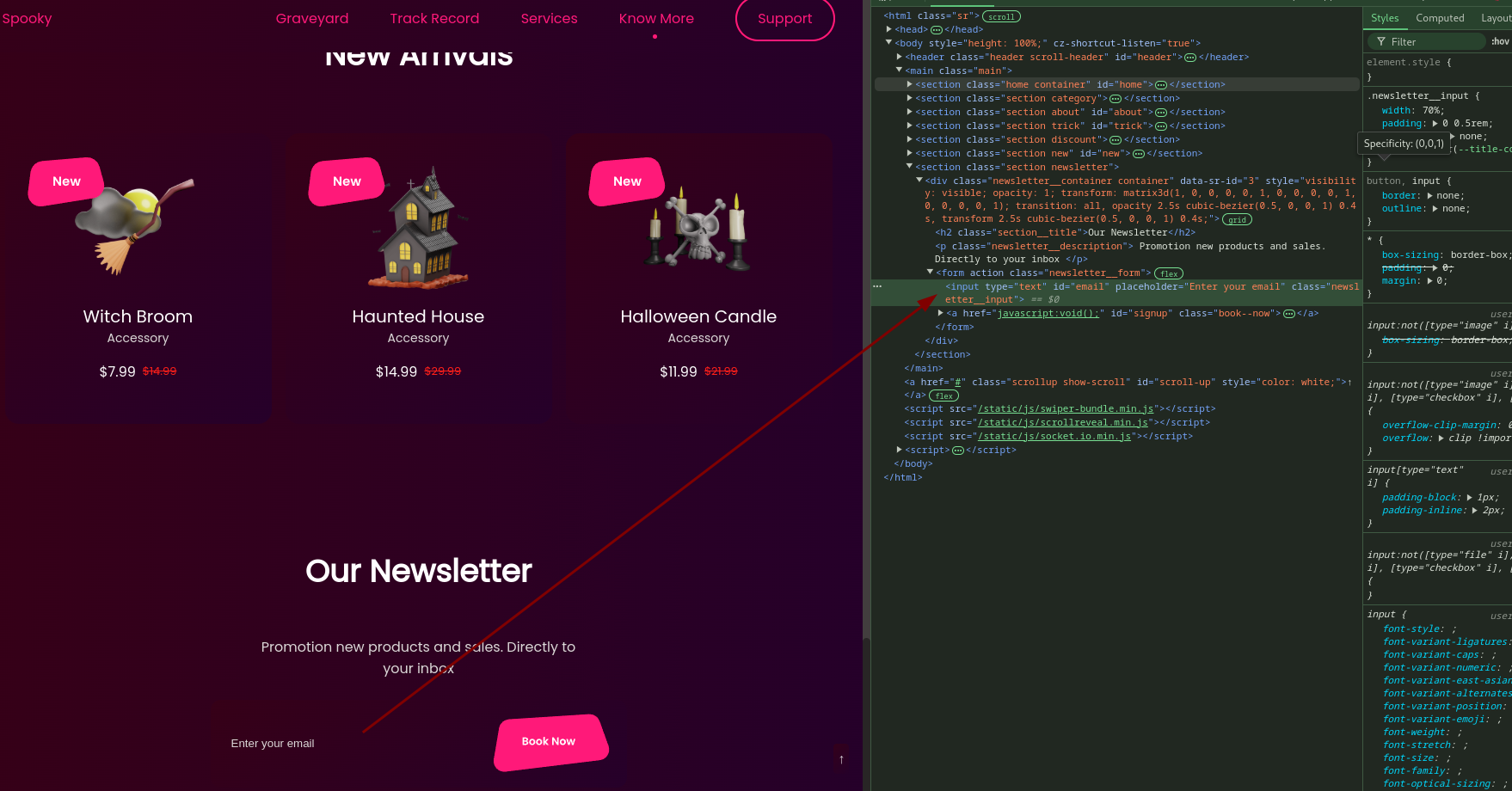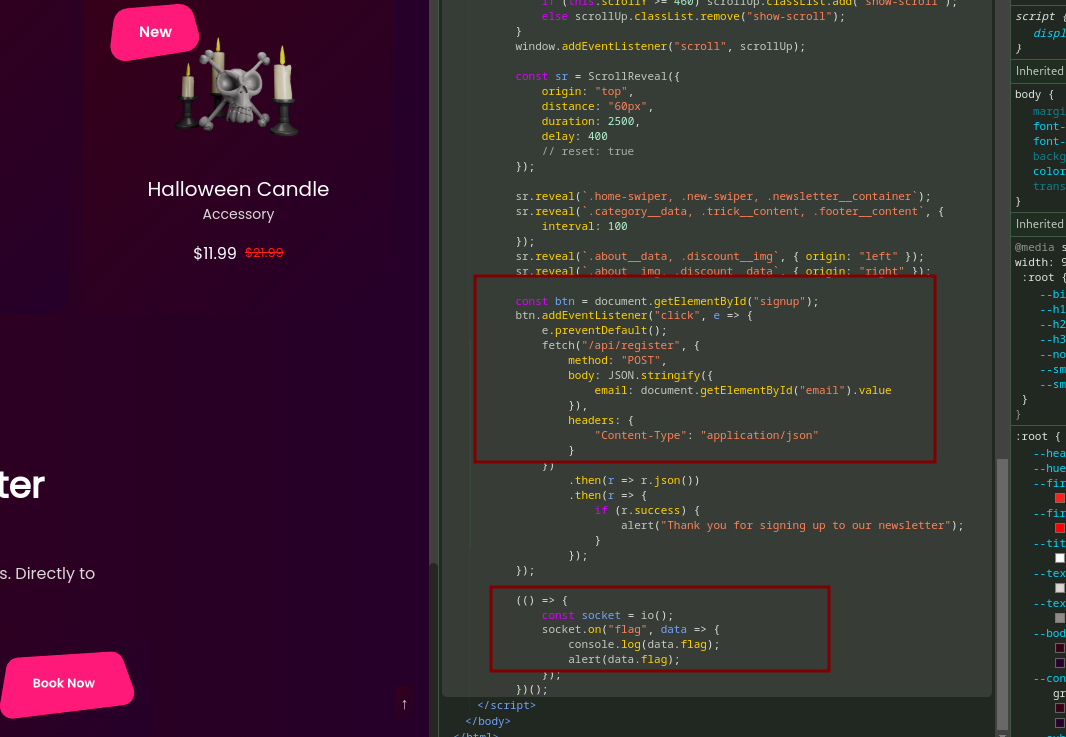HTB - Web Challange - SpookTastic
Review the source code to identify vulnerabilities that may allow bypassing the XSS blocklist.
Recon
Once I started the instance, I opened the website using its IP address for an initial analysis. While exploring the page, I found an email input field at the bottom for newsletter registration. This field sends the user input to the server.
Checking the page source, I discovered JavaScript code containing an API endpoint: /api/register. Since the challenge files were included, I proceeded to analyze the source code.
Source Code Analysis
After unzipping the challenge files, I found a Docker setup for a Flask app. I then opened the app.py file to analyze its logic.
Flask App Code
1
2
3
4
5
6
7
8
9
10
11
12
13
14
15
16
17
18
19
20
21
22
23
24
25
26
27
28
29
30
31
32
33
34
35
36
37
38
39
40
41
42
43
44
45
46
47
48
49
50
51
52
53
54
55
56
57
58
59
60
61
62
63
64
65
66
67
68
69
70
71
72
73
74
75
76
77
78
79
80
81
82
83
84
85
86
87
88
89
90
91
92
93
94
95
96
97
98
99
100
101
102
103
104
105
106
107
108
109
110
111
112
113
114
115
116
import random, string
from flask import Flask, request, render_template, abort
from flask_socketio import SocketIO
from threading import Thread
app = Flask(__name__)
socketio = SocketIO(app)
registered_emails, socket_clients = [], {}
generate = lambda x: "".join([random.choice(string.hexdigits) for _ in range(x)])
BOT_TOKEN = generate(16)
def blacklist_pass(email):
email = email.lower()
if "script" in email:
return False
return True
def send_flag(user_ip):
for id, ip in socket_clients.items():
if ip == user_ip:
socketio.emit("flag", {"flag": open("flag.txt").read()}, room=id)
def start_bot(user_ip):
from selenium import webdriver
from selenium.webdriver.chrome.options import Options
from selenium.webdriver.chrome.service import Service
from selenium.webdriver.support.ui import WebDriverWait
from selenium.webdriver.support import expected_conditions as EC
host, port = "localhost", 1337
HOST = f"http://{host}:{port}"
options = Options()
options.add_argument("--headless")
options.add_argument("--no-sandbox")
options.add_argument("--disable-dev-shm-usage")
options.add_argument("--disable-infobars")
options.add_argument("--disable-background-networking")
options.add_argument("--disable-default-apps")
options.add_argument("--disable-extensions")
options.add_argument("--disable-gpu")
options.add_argument("--disable-sync")
options.add_argument("--disable-translate")
options.add_argument("--hide-scrollbars")
options.add_argument("--metrics-recording-only")
options.add_argument("--mute-audio")
options.add_argument("--no-first-run")
options.add_argument("--dns-prefetch-disable")
options.add_argument("--safebrowsing-disable-auto-update")
options.add_argument("--media-cache-size=1")
options.add_argument("--disk-cache-size=1")
options.add_argument("--user-agent=HTB/1.0")
service = Service(executable_path="/usr/bin/chromedriver")
browser = webdriver.Chrome(service=service, options=options)
try:
browser.get(f"{HOST}/bot?token={BOT_TOKEN}")
WebDriverWait(browser, 3).until(EC.alert_is_present())
alert = browser.switch_to.alert
alert.accept()
send_flag(user_ip)
except Exception as e:
pass
finally:
registered_emails.clear()
browser.quit()
@app.route("/")
def index():
return render_template("index.html")
@app.route("/api/register", methods=["POST"])
def register():
if not request.is_json or not request.json["email"]:
return abort(400)
if not blacklist_pass(request.json["email"]):
return abort(401)
registered_emails.append(request.json["email"])
Thread(target=start_bot, args=(request.remote_addr,)).start()
return {"success": True}
@app.route("/bot")
def bot():
if request.args.get("token", "") != BOT_TOKEN:
return abort(404)
return render_template("bot.html", emails=registered_emails)
@socketio.on("connect")
def on_connect():
socket_clients[request.sid] = request.remote_addr
@socketio.on("disconnect")
def on_disconnect():
del socket_clients[request.sid]
if __name__ == "__main__":
app.run(host="0.0.0.0", port=1337, debug=False)
Analyzing /api/register Endpoint
The /api/register route handles user email registration.
1
2
3
4
5
6
7
8
9
10
11
@app.route("/api/register", methods=["POST"])
def register():
if not request.is_json or not request.json["email"]: # Check if the request contains JSON data with an email
return abort(400)
if not blacklist_pass(request.json["email"]): # Validate user input with blacklist_pass function
return abort(401)
registered_emails.append(request.json["email"]) # If valid, add the email to registered_emails
Thread(target=start_bot, args=(request.remote_addr,)).start() # Start a new bot process
return {"success": True}
Steps of this function:
- It checks if the request contains JSON data with an email. If not, it returns a 400 status.
- The email is then passed to the blacklist_pass function for validation.
- If the email is valid, it is added to registered_emails.
- A new thread starts the
start_botfunction, passing the user’s IP address as an argument.
Analyzing blacklist_pass Function
1
2
3
4
5
6
7
def blacklist_pass(email):
email = email.lower()
if "script" in email:
return False
return True
This function tries to prevent XSS by blocking emails that contain the word “script”. However, this check is weak because it only filters “script” instead of validating all possible XSS payloads. This makes it a vulnerable point for exploitation.
Understanding start_bot Function
1
2
3
4
5
6
7
8
9
10
11
12
13
14
15
16
17
18
19
20
21
22
23
24
25
26
27
28
29
30
31
32
33
34
35
36
37
38
39
40
41
42
43
44
45
46
47
48
def start_bot(user_ip):
from selenium import webdriver
from selenium.webdriver.chrome.options import Options
from selenium.webdriver.chrome.service import Service
from selenium.webdriver.support.ui import WebDriverWait
from selenium.webdriver.support import expected_conditions as EC
host, port = "localhost", 1337
HOST = f"http://{host}:{port}"
options = Options()
options.add_argument("--headless")
options.add_argument("--no-sandbox")
options.add_argument("--disable-dev-shm-usage")
options.add_argument("--disable-infobars")
options.add_argument("--disable-background-networking")
options.add_argument("--disable-default-apps")
options.add_argument("--disable-extensions")
options.add_argument("--disable-gpu")
options.add_argument("--disable-sync")
options.add_argument("--disable-translate")
options.add_argument("--hide-scrollbars")
options.add_argument("--metrics-recording-only")
options.add_argument("--mute-audio")
options.add_argument("--no-first-run")
options.add_argument("--dns-prefetch-disable")
options.add_argument("--safebrowsing-disable-auto-update")
options.add_argument("--media-cache-size=1")
options.add_argument("--disk-cache-size=1")
options.add_argument("--user-agent=HTB/1.0")
service = Service(executable_path="/usr/bin/chromedriver")
browser = webdriver.Chrome(service=service, options=options)
try:
browser.get(f"{HOST}/bot?token={BOT_TOKEN}")
WebDriverWait(browser, 3).until(EC.alert_is_present())
alert = browser.switch_to.alert
alert.accept()
send_flag(user_ip)
except Exception as e:
pass
finally:
registered_emails.clear()
browser.quit()
This function does the following:
- Starts a headless Selenium Chrome browser.
- Opens the
/botpage with a secret bot token. - Waits for an alert pop-up on the webpage.
- If an alert appears, it calls
send_flag(user_ip).
XSS Vulnerability in bot.html
The bot.html template renders registered emails without sanitization:
1
2
3
{for email in emails}
<span></span><br/>
{endfor}
Since the email input is directly inserted into the HTML without escaping, any JavaScript code inside the email will execute.
The send_flag function sends the user’s flag through an open socket connection if their IP matches a connected client.
1
2
3
4
def send_flag(user_ip):
for id, ip in socket_clients.items():
if ip == user_ip:
socketio.emit("flag", {"flag": open("flag.txt").read()}, room=id)
This allows the bot to send the flag only to the attacker’s session upon successful XSS execution.
Exploitation
The blacklist only blocks the word “script”. This means we can bypass the filter using a different XSS payload.
Bypassing the Blacklist
Instead of using a <script> tag, we can use an <img> tag with an onerror event:
<img src=0 onerror=alert(1) />
Attack Steps:
- Submit the payload as an email:
<img src=0 onerror=alert(1) /> - The input passes the blacklist_pass check since it does not contain “script”.
- The bot processes the input and renders it in bot.html, where it executes as JavaScript.
- The alert pops up, and the bot calls send_flag(user_ip), sending us the flag.
Conclusion
This challenge demonstrates how weak blacklist-based XSS protection can be bypassed. Instead of blocking specific words like “script”, proper input validation and output encoding should be used to prevent XSS attacks.

